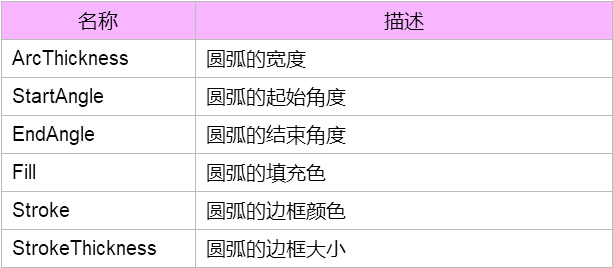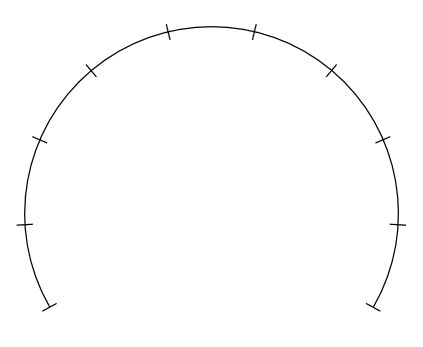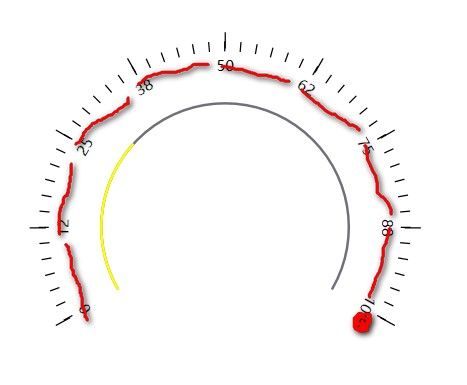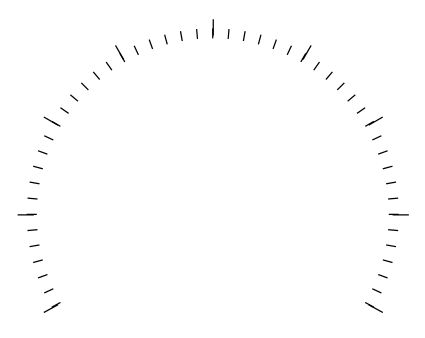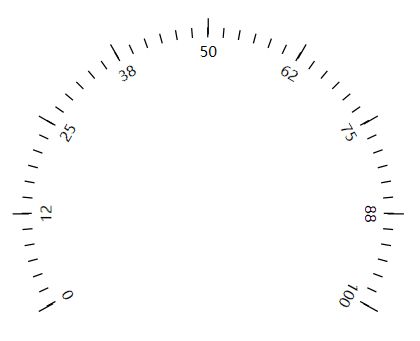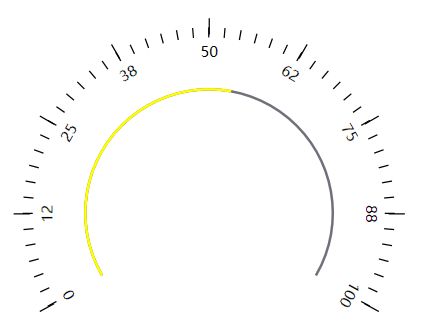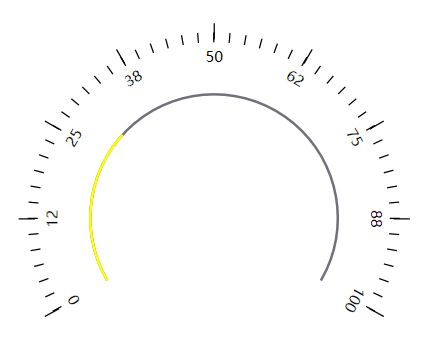1、确定控件应该继承的基类
2、设置Dashboard的样式
主要注意的是,因为我们还不知道Dashboard内部到底有哪些东西,因此这里先放置了一个Grid,后面所有的代码将在
3、确定控件的内部基本构造
该表盘控件从表面上看去,共由三个部分组成
- 有文字显示的刻度
- 有进度展示的圆弧(红色与灰色部分的圆弧)
- 中间偏下的内容展示区域
3.1、PathListBox
xmlns:ec="http://schemas.microsoft.com/expression/2010/controls"
②、具体用法
然后放置PathListBox,在PathListBox的LayoutPath中去设置PathListBox应该按照哪个路径去排列,在ItemsTemplate中设置每个Item子项应该呈现成什么效果,最后在后台设置PathListBox的ItemsSource,设置PathListBox一共有几个Item子项。完整代码如下:
其中Distributeion与Orientation是关键属性,SourceElement指向的就是PathListBox的排列路径。最终效果如下图所示:
3.2、Arc
xmlns:ec="http://schemas.microsoft.com/expression/2010/controls"
②、具体用法
4、正式构建控件
4.1、刻度部分
4.1.1、长刻度部分
但是这样只能看到圆弧,并没有看到PathListBox的刻度效果,因为PathListBox没有设置ItemsSource。而且由于我们是在自定义控件,因此为了设置PathListBox的ItemsSource的值,我们需要在Dashboard定义一个依赖属性LongTicksInternal,由于我们并不希望用户能够在外面能够设置LongTicksInternal的值,因此在依赖属性的set的时候,设置其访问权限,设置成private,这样就只能在样式里面访问该依赖属性,用户在外面使用的时候是看不到这个依赖属性的。
#region LongTicksInternal 长刻度集合
public IList定义了该依赖属性之后,将该依赖属性给绑定到PathListBox的ItemsSource上面去
ItemsSource="{TemplateBinding ShortTicks}"
绑定了依赖属性之后还是不能显示,因为LongTicksInternal目前是空的一个集合,还需要给LongTicksInternal赋值。
public Dashboard()
{
this.LongTicksInternal = new List();
for (int i = 0; i < 10; i++)
{
this.LongTicksInternal.Add(i);
}
}
效果如下:
#region LongTickCount 长刻度个数
public int LongTickCount
{
get { return (int)GetValue(LongTickCountProperty); }
set { SetValue(LongTickCountProperty, value); }
}
public static readonly DependencyProperty LongTickCountProperty =
DependencyProperty.Register("LongTickCount", typeof(int), typeof(Dashboard), new PropertyMetadata(5));
#endregion
改动下上面的for循环代码,这样就可以灵活的设置长刻度的个数了。
for (int i = 0; i < this.LongTickCount; i++)
{
this.LongTicksInternal.Add(i);
}
4.1.2、短刻度部分
再次定义一个Path与一个PathListBox,并新增一个依赖属性,用来设置PathListBox的ItemsSource
短刻度个数的依赖属性
#region ShortTicksInternal 短刻度集合
public IList ShortTicksInternal
{
get { return (IList)GetValue(ShortTicksInternalProperty); }
set { SetValue(ShortTicksInternalProperty, value); }
}
public static readonly DependencyProperty ShortTicksInternalProperty =
DependencyProperty.Register("ShortTicksInternal", typeof(IList), typeof(Dashboard));
#endregion
但由于短刻度会有很多,不可能去细数表盘一共有多少个短刻度,而且如果手动设置所有的短刻度个数,会有一个问题就是短刻度和长刻度不会重合,导致宽的宽,窄的窄。我们不知道所有的短刻度个数,但是我们可以知道2个长刻度之间有多少个短刻度,因此定义一个ShortTickCount,用来设置2个长刻度间的短刻度的个数
#region ShortTickCount 短刻度个数
public int ShortTickCount
{
get { return (int)GetValue(ShortTickCountProperty); }
set { SetValue(ShortTickCountProperty, value); }
}
public static readonly DependencyProperty ShortTickCountProperty =
DependencyProperty.Register("ShortTickCount", typeof(int), typeof(Dashboard), new PropertyMetadata(5));
#endregion
根据LongTickCount与ShortTickCount,生成ShortTicksInternal
this.ShortTicksInternal = new List();
for (int i = 0; i < (this.LongTickCount - 1) * (this.ShortTickCount + 1) + 1; i++)
{
this.ShortTicksInternal.Add(new object());
}
4.1.3、文字部分
上一节已经将刻度做出来了,还差一个文字部分。文字部分与刻度部分同理,只不过不显示成刻度了,需将每个Item的样式设置成TextBlock
#region NumberListInternal 数字集合
public IList NumberListInternal
{
get { return (IList)GetValue(NumberListInternalProperty); }
set { SetValue(NumberListInternalProperty, value); }
}
public static readonly DependencyProperty NumberListInternalProperty =
DependencyProperty.Register("NumberListInternal", typeof(IList), typeof(Dashboard));
#endregion
由于表盘上面显示的数字会有不同,因此应该让其可以设置,因此定义一个最大值与最小值的依赖属性,表盘上面的文字应该根据这两个属性来自动生成
#region Minimum 最小值
///
/// 最小值依赖属性,用于Binding
///
public static readonly DependencyProperty MinimumProperty =
DependencyProperty.Register(
"Minimum",
typeof(double),
typeof(Dashboard),
new PropertyMetadata(0.0));
///
/// 获取或设置最小值.
///
/// 最小值.
public double Minimum
{
get { return (double)GetValue(MinimumProperty); }
set { SetValue(MinimumProperty, value); }
}
#endregion
#region Maximum 最大值
///
/// 最大值依赖属性,用于Binding
///
public static readonly DependencyProperty MaximumProperty =
DependencyProperty.Register(
"Maximum",
typeof(double),
typeof(Dashboard),
new PropertyMetadata(100.0));
///
/// 获取或设置最大值.
///
/// 最大值.
public double Maximum
{
get { return (double)GetValue(MaximumProperty); }
set { SetValue(MaximumProperty, value); }
}
#endregion
由于文字只在长刻度下面显示,因此在设置Long的for循环中设置的值
this.NumberListInternal = new List();
for (int i = 0; i < this.LongTickCount; i++)
{
this.NumberListInternal.Add(Math.Round(this.Minimum + (this.Maximum - this.Minimum) / (this.LongTickCount - 1) * i));
this.LongTicksInternal.Add(i);
}
算法解析:上面已经说到,我们将表盘刻度分成了8份,那么 (this.Maximum - this.Minimum) / (this.LongTickCount - 1) 可以得到每一份所代表的值,每一份乘以i,就表示接下来的每份的值,但是表盘不可能永远都是从0开始的,我们会给它设置最小值,因此得加上Minimum,最后得出来的结果有可能会有小数点,为了省去这个小数点,使用了Math.Round()函数来取整。至此,刻度与数字部分完成了。
4.2、进度(当前值)部分
这段圆弧一共由两个圆弧组成,红色表示当前值,灰色只是作为底色展示用的,并无太大作用
效果如下:
#region Value 当前值
///
/// 最大值依赖属性,用于Binding
///
public static readonly DependencyProperty ValueProperty =
DependencyProperty.Register(
"Value",
typeof(double),
typeof(Dashboard),
new PropertyMetadata(0.0, new PropertyChangedCallback(OnValuePropertyChanged)));
///
/// 获取或设置当前值
///
public double Value
{
get { return (double)GetValue(ValueProperty); }
set { SetValue(ValueProperty, value); }
}
private static void OnValuePropertyChanged(DependencyObject d, DependencyPropertyChangedEventArgs e)
{
//Dashboard dashboard = d as Dashboard;
//dashboard.OldAngle = dashboard.Angle;
//dashboard.SetAngle();
//dashboard.TransformAngle();
}
#endregion
之外为了设置圆弧的角度,还需要新增一个Angle依赖属性
#region Angle
public double Angle
{
get { return (double)GetValue(AngleProperty); }
set { SetValue(AngleProperty, value); }
}
public static readonly DependencyProperty AngleProperty =
DependencyProperty.Register("Angle", typeof(double), typeof(Dashboard), new PropertyMetadata(0d));
#endregion
在代码中,根据Value的值,自动设置Angle
private void SetAngle()
{
var diff = this.Maximum - this.Minimum;
var valueDiff = this.Value - this.Minimum;
this.Angle = -120 + (120 - (-120)) / diff * valueDiff;
}
算法解析:结束角度-起始角度可以得出圆弧总共经过的角度值,除以最大值与最小值的差值,得到1°对应的数值,乘以当前值与最小值的差值就可以得到差值所对应的角度总和了。由于起始角度不固定,因此最终的角度值应该是:起始角度+差值角度和
这里面有一个不足的地方就是起始角度和结束角度硬编码成-120和120了,为了灵活性,可以将其设置为2个依赖属性,这个就自己去弄吧,这里就不贴出代码了。
代码下载:https://github.com/zhidanfeng/WPF.UI


